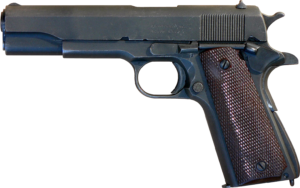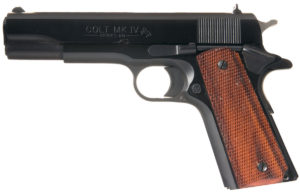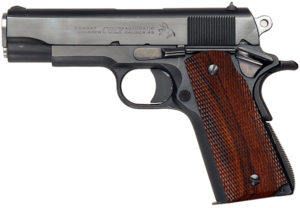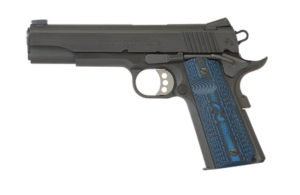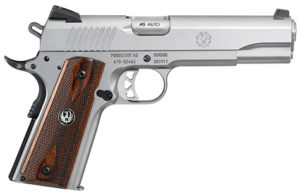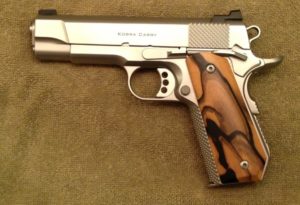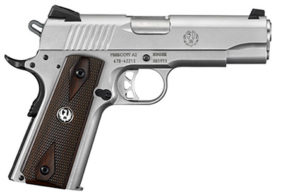As an older person, I have been privileged to grow up around firearms in the pre-polymer firearms period. That’s not to say that my knowledge, or experience, about firearms is extensive. In fact, by some, I would still be considered a neophyte when it comes to firearms. As I gained more familiarization and experience with firearms, especially through the military, I have come to appreciate all manner of firearms. The 1911-based pistol; however, has always been a standout from the crowd to me.
My first introduction to the 1911-based pistol was in the military and that introduction was a disaster. While my hands had wrapped around an M14 and M16, the M1911 was the first pistol that I had ever fired in my life. In fact, it was the first handgun that I had ever fired in my life. It was a humbling experience at the time, but I am glad to say that because of it, I am somewhat proficient with the 1911-based pistol today. However, it was many years until I would finally come to appreciate what John Moses Browning had presented to the world.
By the time that I entered life as a LEO, the Beretta 92F had been adopted by the military as a political nod to NATO. The department that I worked for allowed us to decide what to carry as our duty firearm. While I had gained experience with revolvers that included .38 special and .357 magnum, the calibers were not my choice for something that I wanted to carry. The .38 special I considered under-powered (although it is been the standard for law-enforcement use for decades), and I felt the .357 magnum over-powered for most situations that I would find myself in. I still cannot explain why I choose a firearm that had embarrassed me at one time, but a blued, Colt Series 80 MKIV “Government Model” pistol was my choice of carry. I carried the Colt until the department forced me to not carry the Colt on duty. However, the department allowed me to carry it off-duty as long as I could qualify with it. While the Colt Series 80 MKIV “Government Model” pistol became my off-duty carry at the beginning, it was replaced by a Colt Series 80 MKIV “Combat Commander” that was easier to conceal while out in public. The 1911-based pistol became my everyday companion and I soon learned about other offerings of the 1911; the “Officer Model” and the “Lightweight Commander.” The Sig Sauer P220 took over duty as my duty pistol, but that was short-lived by another department edict – the transition to the Smith & Wesson 686 4” revolver. The S&W 686 is not a firearm that I wished to carry off-duty and the 1911-based pistol remained in that role. While I was in a forced marriage with the S&W 686, the 1911-based pistol was my mistress.The department eventually made its way with the Beretta 92, and subsequently to the Glock 9mm. The department did it without me; however, as I had left law enforcement to move on into other areas such as private security and executive protection. The 1911 remained my first choice of carry while “off the job” because of state mandates as to what security personnel could carry relative to the caliber of ammunition while working in a “security” capacity. I finally had my fill of “serving and protecting” and due to my becoming older, wiser, battered, and bruised, I returned to civilian life. The 1911-based pistol had been with me through it all and I saw no reason to cut it loose.
Browning’s basic M1911 design has seen very little change throughout its production life. Since its adoption by the Army on March 29, 1911, the 1911 design as served as the foundation for many calibers including; .45 ACP, (Automatic Colt Pistol), .38 Super, 9×19mm Parabellum, 7.65mm Parabellum, 9mm Steyr,.400 Corbon, .40 Smith & Wesson, 10mm and other cartridges to include the .45 Winchester Magnum, .357 magnum, and .44 magnum. Although the 1911-based pistol originally was designed for a single-stack magazine, some 1911-based pistols accommodate staggered magazines that increase the storage capacity to 14+ cartridges.
Some consider the lack of storage capacity (in addition to the weight of the pistol) to be the bane of the 1911. Consider; however, as to when the 1911 became a fighting handgun, and more importantly, why it came into existence. The answer is simple; repeatable stopping power. The original 1911 launched a 230-grain bullet at 825 feet per second. Today, versions of the 1911-based pistol can launch a .45 caliber, 165-grain bullet at speeds of 1225 feet per second (Cor-Bon 165-grain Pow’RBall +P (PB45165/20) or a 230-grain bullet at 890 feet per second American Eagle (Federal) 230-grain Full Metal Jacket (AE45A) out of a 5” barrel (the original “Government” model design). Through the use of easily-exchangeable lighter or heavier recoil springs (spring rate), the 1911-based pistol can be customized to shoot a wide variety of .45 ACP cartridges. Colt placed the 1911-based pistol for commercial use in three categories; Government (5” barrel), Commander (4.25” barrel), and Officer (3.5” barrel), which is still used as a comparison between 1911 pistols. The 1911 has also been manufactured with long slides and in sub-compact models (3” barrels).While weight is still a factor that prevents many from adopting the 1911 platform, there are many 1911-based pistols available today in lightweight configurations; albeit, they are usually found in the Commander, Officer, and sub-compact versions and all are very conducive for concealed carry.
The 1911-based pistol is by far one of the safest single-action pistols to carry in Condition 1 (Cocked and Locked) because of its active safety controls; a grip safety and a thumb safety. As a side note, the grip safety was incorporated into the original design of the 1911 pistol; the military requested the thumb safety due to safety concerns for the troops who carried the 1911 (probably more for the personnel that might be around a 1911 operator). Personally, I have never been partial to passive safeties on a firearm; those safety devices that don’t require intervention for their operation. In my mind, passive safeties are like handing over the reins of the horse you are riding to someone else – it puts the control in their hands and not mine. The 1911-based pistol is one of the most customizable pistols on the market. A 1911-based pistol can be purchased in its original configuration (as it was adopted by the military), or purchased with the latest and greatest modifications as standard fare. There are inexpensive models that are perfectly suitable out-of-the-box for competition or defensive use and there are models that can destroy a bank account in short order. The 1911-based pistol can be a tinker’s dream or nightmare. There are many who have never fired a 1911-based pistol and there are those who have owned and/or carried them and have since moved on to more modern polymer pistols like the Glock. I have carried all manner of pistol at one time or another – both with and without active safety devices. But, for some reason, I seem to always return to the 1911 platform. The slimness of the pistol, the simplicity and execution of design, the single-action trigger pull, and the way it feels in my hand has always appealed to me and has always felt like it belonged there.Since my first introduction to the 1911 platform, I have had the pleasure of shooting and owning many 1911-based pistols. There was also one that was not so pleasurable. Not to mention any names, but the name was very similar to an animal called a Llama.
While caliber is not a major concern to me, keeping my rounds on target is. The 1911 platform is simply the best tool for me to do that. That is, with the exception of my Ruger GP141 .357 magnum revolver, this is another story for another time.
Does this mean that I am going to sell any of my pistols that are not 1911 platforms? Hardly! While the 1911 may be my primary PD platform, it would be unwise for me to even consider not being familiar and obtaining proficiency in other pistol platforms. I just never know when I will have to shoot a Glock, Springfield, Smith & Wesson…
![]()


